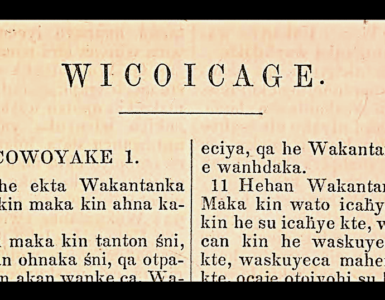 Samuel James Pierce was born to Anne Walthall Spencer and Sterling C. Anderson in Mt. Hybla, Prince Edward County, Virginia, Dec. 25, 1814 (or Dec. 5). The early years of his life were spent in the country on the family farm where his preparation for college included attendance in a local school and instruction from a tutor at home. In 1831 he began college studies in the University of Ohio in Athens, but then for reasons unknown transferred to Hanover College in Indiana. Included among his campus interests was membership in the Union Literary Society, and during his senior year his discourse, “Love of Country,” was included in the society’s annual exhibition. Samuel graduated Hanover in 1836 then moved back to Virginia where he resided in Farmville in order to attend Union Theological Seminary. He completed his divinity education in 1839.
Samuel James Pierce was born to Anne Walthall Spencer and Sterling C. Anderson in Mt. Hybla, Prince Edward County, Virginia, Dec. 25, 1814 (or Dec. 5). The early years of his life were spent in the country on the family farm where his preparation for college included attendance in a local school and instruction from a tutor at home. In 1831 he began college studies in the University of Ohio in Athens, but then for reasons unknown transferred to Hanover College in Indiana. Included among his campus interests was membership in the Union Literary Society, and during his senior year his discourse, “Love of Country,” was included in the society’s annual exhibition. Samuel graduated Hanover in 1836 then moved back to Virginia where he resided in Farmville in order to attend Union Theological Seminary. He completed his divinity education in 1839.
S. J. P. Anderson was licensed to preach by West Hanover Presbytery, March 29, 1839, and then ordained by Orange Presbytery for a dual call to the Oxford and Grassy Creek Churches in North Carolina, November 9, 1839. After a brief ministry in the Tar Heel State he returned to Virginia to serve the congregation in Danville, 1841-1846. From Danville the next move took him to the coast to minister in Norfolk in the First Presbyterian Church. After five years in Norfolk his next call took him west.
In 1851 Rev. Anderson was installed the pastor of the Central Presbyterian Church in St. Louis, Missouri. At the time Dr. Anderson took charge of the church it was experiencing some difficulties. The congregation had been organized just a few years earlier and was barely surviving under a heavy debt incurred from its recently completed building on the northwest corner of Eighth and Locust. Added to financial difficulties was the shock of the recent death of their founding pastor, Rev. Alexander Van Court, from cholera. The task before Anderson was a difficult one, but through faithful preaching, persistence, and the blessing of God, he was able to steady the church and shepherd the congregation. During his ministry the church grew until it became one of the largest congregations in the city.
Dr. Anderson resigned his St. Louis call in 1869 due to some type of disease affecting his throat. With his speaking ability limited, he accepted a position as principle of some type of educational institution, 1870-1872. Dr. Anderson died in Jennings Station, Missouri, September 10, 1873, and was buried in Bellefontaine Cemetery in St. Louis. He was honored with the Doctor of Divinity in 1854 by Centre College in Danville, Kentucky.
 His publications include—The Influence of the Bible on Liberty: An Address Delivered Before the Union Society of Hampden Sidney College, September 18, 1845, Richmond: H. K. Ellyson, 1845; A Memorial of the Rev. Stephen Griffith Gassaway, A.M.: Late Rector of St. George’s Church, Saint Louis, St. Louis: Printed at the Missouri Democrat Office, 1854 (Anderson delivered a commemorative discourse); The Power of a Christian Literature: A Sermon on Behalf of the Assembly’s Board of Publication, Philadelphia: Presbyterian Board of Publication, 1858; The Dangers and Duties of the Present Crisis! A Discourse: Delivered in the Union Church, St. Louis, January 4, 1861, St. Louis: Presbyterian of Our Union Job Print, 1861; and six articles listed in Wayne Sparkman’s “Author-Title Index for The Southern Presbyterian Review,” on the PCA Historical Center website.
His publications include—The Influence of the Bible on Liberty: An Address Delivered Before the Union Society of Hampden Sidney College, September 18, 1845, Richmond: H. K. Ellyson, 1845; A Memorial of the Rev. Stephen Griffith Gassaway, A.M.: Late Rector of St. George’s Church, Saint Louis, St. Louis: Printed at the Missouri Democrat Office, 1854 (Anderson delivered a commemorative discourse); The Power of a Christian Literature: A Sermon on Behalf of the Assembly’s Board of Publication, Philadelphia: Presbyterian Board of Publication, 1858; The Dangers and Duties of the Present Crisis! A Discourse: Delivered in the Union Church, St. Louis, January 4, 1861, St. Louis: Presbyterian of Our Union Job Print, 1861; and six articles listed in Wayne Sparkman’s “Author-Title Index for The Southern Presbyterian Review,” on the PCA Historical Center website.
BARRY WAUGH
Sources—Information about the Central Presbyterian Church is from vol. 3 of Encyclopedia of the History of St. Louis, New York: The Southern History Company, 1899; Information about Anderson’s parents is from his Find-a-Grave entry; Robert H. Stone, A History of Orange Presbytery, 1770-1970, Greensboro, 1970; the biographical catalogs of Hanover College and Union Seminary; the two portraits were provided courtesy of Wayne Sparkman of the PCA Historical Center in St. Louis; and The Church on the Elizabeth River: A Memorial of the Two Hundred and Tenth Anniversary of the First Presbyterian Church of Norfolk, VA., 1682-1892, Richmond: Whittet & Shepperson, [1892] which is essentially the same information available in Nevin’s Encyclopedia of the Presbyterian Church.





